the place where Paleontology and Paleoanthropology meets Philately
Paleoanthropology
"Paleoanthropology, also spelled Palaeoanthropology, also called Human Paleontology, interdisciplinary branch of anthropology concerned with the origins and development of early humans." Encyclopedia Britannica
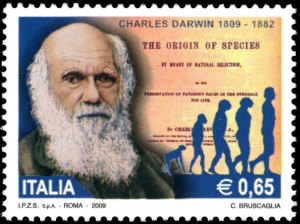 |
| Charles Darwin and human evolution sequence on stamp of Italy 2009, MiNr.: 3280; Scott: 2911. |
Don't miss it with Archeology and Anthropology.
Archeology - science about modern human activity through the recovery and analysis of material culture.
Anthropology - science about modern humans and human behavior and societies in the past and present.
Fossil can be of different types: entire, fragmented skeletons or just a single bones or teeths, tissue or even entire bodies preserved in permafrost, footprints etc.
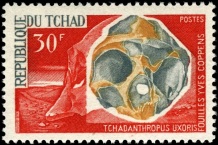 |
 |
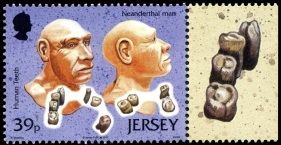 |
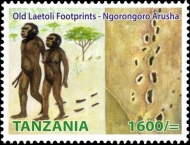 |
| Skull of Tchadanthropus uxoris on stamp of Chad 1966 MiNr.: 162 , Scott: 133. | Skull of "Broken Hill Man" (Homo rhodesiensis) on stamp from "Fossils from Luangwa" set of Zambia 1973 MiNr.: 98 , Scott: 95. | Neanderthal man on stamp from "Jersey Archaeology La Cotte de St Brelade" set of Jersey 2010 MiNr.: 15121 , Scott: 1476. | Laetoli hominids and their footprints on stamp from "Tanzania heritage sites" set of Tanzania 2014 MiNr.: 5182 , Scott: 2752. |
Scientists who study this fossils called Paleoanthropologists or Palaeoanthropologists.
They dig for fossils in the field, bringing them to universities, labs or museums where they dissect, study and assemble it.
In the field, discovering physical remains and other fossils follows painstaking procedures similar to those archaeologists use when uncovering cultural remains.
Once remains are discovered, they are usually sent to a laboratory or research center where they are carefully studied, using chemical and physical dating methods, X-Rays, MRIs, and other special tools. Paleoanthropologists are most interested in noting how the finds are similar and how they are different from already established ancestral lines. [R3]
Results of their study, allows us to restore human evolution tree and make some reconstruction of prehistoric hominids and humans, as represented on many stamps from around the world.
A hominid, according to the Oxford Dictionary, is a primate of the family Hominidae, which includes humans and their prehistoric ancestors. The Hominidae also (at least in many hypothesized trees) includes the great apes (Orangutans, Gorillas, and Chimpanzees).
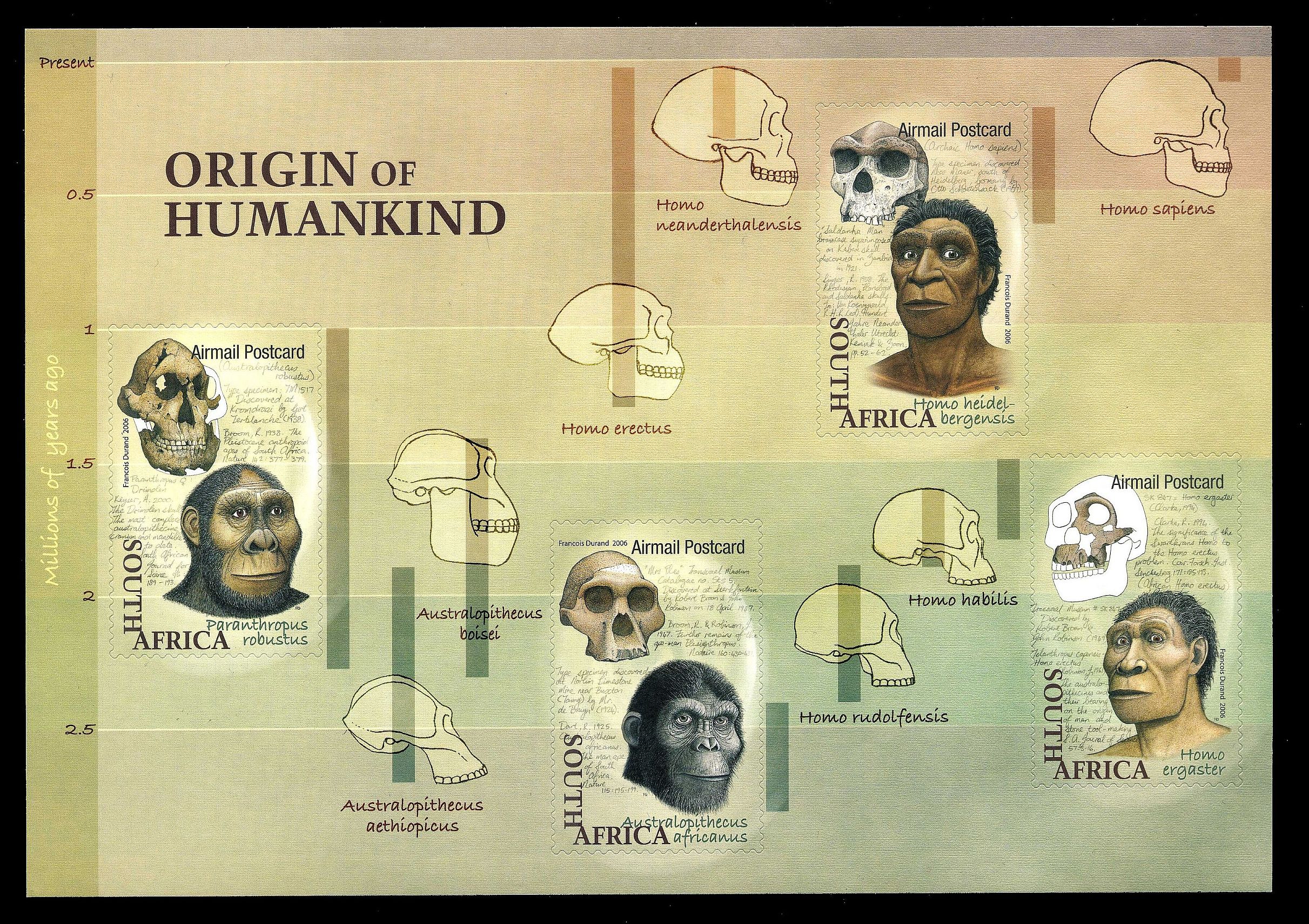
Human evolution on stamps of South Africa 2006
The modern field of Palaeoanthropology began in the 19th century with the discovery of a partial skeleton in the Neanderthal Valley, near Dusseldorf in Germany. In August, 1856, the partial skeleton of an ancient man was discovered in a German cave, the Kleine Feldhofer Grotte, in the Neandertal valley, 13 km east of Düsseldorf.
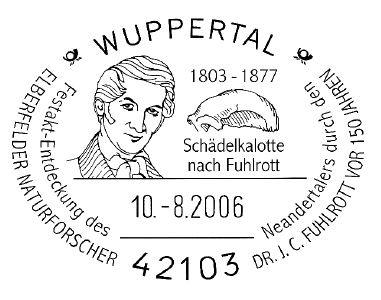 |
| Johann Carl Fuhlrott with skull of Neanderthal on commemorative postmark of Germany from 2006, |
The report about the discovery brought the find to the attention of two Bonn professors of anatomy, Hermann Schaaffhausen and August Franz Josef Karl Mayer. They contacted Fuhlrott and asked him to send the bones to them.
Six months later Schaaffhausen and Fuhlrott presented results of their study to the members of the Natural History Society of the Prussian Rhineland and Westphalen. They concluded that the bones belonged to a representative of a native tribe who had inhabited Germany before the arrival of the ancestors of modern humans. The news was a worldwide sensation. Schaaffhausen continued to study these fossils and published results of his research in several international scientific magazines.
In 1863, an Anglo-Irish geologist at Queen's College Galway, William King, was the first to propose that the bones found in the German valley of Neandertal in 1856 were not of Homo sapiens, but of a distinct species: Homo neanderthalensis. He proposed the name of this new species at a meeting of the British Association in 1863, with the written version published in 1864.
The fossils from the Neanderthal Valley were not the first Neandertal fossil discovery. Other Neandertal fossils had been discovered earlier, but their true nature and significance had not been recognized, and, therefore, no separate species name was assigned. The Publication of Charles Darwin's "Origin of Species" in 1859 awoke public and scientific interest in the origin of humans. Naturalists started to search for bones of unknown humankind in the field and in the museum collections around the world.
 |
| Discovery of Neanderthal's skull in Forbes' Quarry, in Gibraltar in 1859 |
The skull was presented to the Gibraltar Scientific Society by its secretary, Lieutenant Edmund Henry Réné Flint, on 3 March 1848, but its significance was not recognized until after the discovery of the skull from the Neandertal Valley.
The skull is known as Gibraltar-1 today, was brought out of obscurity, and presented at a meeting in the British Association for the Advancement of Science in 1864, at Norwich, England.
Charles Darwin was not present, but the skull was later examined by both Darwin and Thomas Huxley, who concluded the skull was that of an extinct human species. Charles Darwin did however make fleeting reference to Gibraltar-1 in his 1871 publication, “The Descent of Man”.
The skull is dated to between 30 thousand and 50 thousand years old.
A cast of the skull can be viewed at the Gibraltar Museum – the original is on display in the Human Evolution gallery of the Natural History Museum in London. Lately, the skull has become the subject of debate about whether to return it to Gibraltar or not.
In 1912, Charles Dawson, a British amateur archaeologist, claimed that he had discovered the "missing link" between early apes and man. He contacted Arthur Smith Woodward, Keeper of Geology at the Natural History Museum in London, stating he had found a section of a human-like skull in Pleistocene gravel beds near Piltdown, East Sussex.
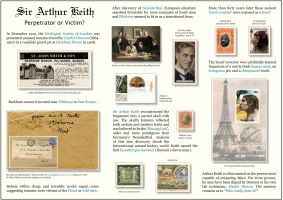 |
| One slide presentation "Sir Arthur Keith perpetrator or victim", creatd by Mr. Fran Adams from USA |
The questionable significance of the assemblage remained the subject of considerable controversy until it was conclusively exposed in 1953 as a forgery. It was found to have consisted of the altered mandible and some teeth of an orangutan deliberately combined with the cranium of a fully developed, though small-brained, modern human.
The Piltdown Man fraud significantly affected early research on human evolution.
Notably, it led scientists down a blind alley in the belief that the human brain expanded in size before the jaw adapted to new types of food. Discoveries of Australopithecine fossils such as the Taung Child found by Raymond Dart during the 1920s in South Africa were ignored because of the support for Piltdown Man as "the missing link," and the reconstruction of human evolution was confused for decades.
Stephen Jay Gould, an American paleontologist, evolutionary biologist, and historian of science, argued that nationalism and cultural prejudice played a role in the ready acceptance of Piltdown Man as genuine, because it satisfied European expectations that the earliest humans would be found in Eurasia, and the British in particular wanted a "first Briton" to set against fossil hominids found elsewhere in Europe.
Piltdown man, whose fossils were sufficiently convincing to generate a scholarly controversy lasting more than 40 years, was one of the most successful hoaxes in the history of science.
Some naturalists who was searching for the fossils of prehistoric humans turned their attention to Asia.
In 1918 Swedish geologist Johan Gunnar Andersson first started his explorations at an archaeological site near the village of Zhoukoudian, Beijing municipality in China. He was intrigued by tales of “dragon bones” that local people found in the clefts and used for medicinal purposes.
 |
| Postal stationery of China 2018 - "The Centenary of the discovery of Zhoukoudian site" |
During their exploration, Andersson discovered some quartz pieces that could have been used as early cutting tools. This discovery lent credence to his theory that the bones were actually human fossils.
The excavation continued by Austrian palaeontologist Otto Zdansky in 1921 and 1923 unearthed two human teeth. These were later identified by Canadian paleoanthropologist Davidson Black as belonging to a previously unknown species, which he named Sinanthropus pekinensis. In 1929 the first skullcap was unearthed at the site by Chinese palaeontologist Pei Wenzhong.
So far, ancient hominid fossils, cultural remains, and animal fossils have been excavated from 23 localities by international scientists in the Zhoukoudian area. These artefacts and remains date between 5 million and 10,000 years old. These include the remains of Homo erectus pekinensis, which are commonly known as the Peking man, who lived during the Middle Pleistocene (700,000 to 200,000 years ago), archaic Homo sapiens from about 200,000–100,000 years ago and Homo sapiens sapiens dating back to 30,000 years ago.
At about the same time Andersson, Granger, and Zdansky were reporting new hominds excavated in China, the first palaeoanthropological finds were being made in Africa.
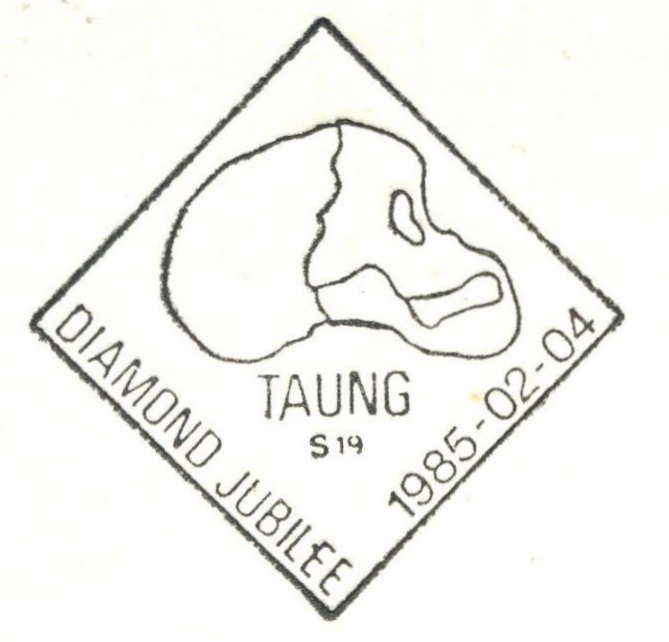 |
| Taung skull on commemorative postmark of Bophuthatswana |
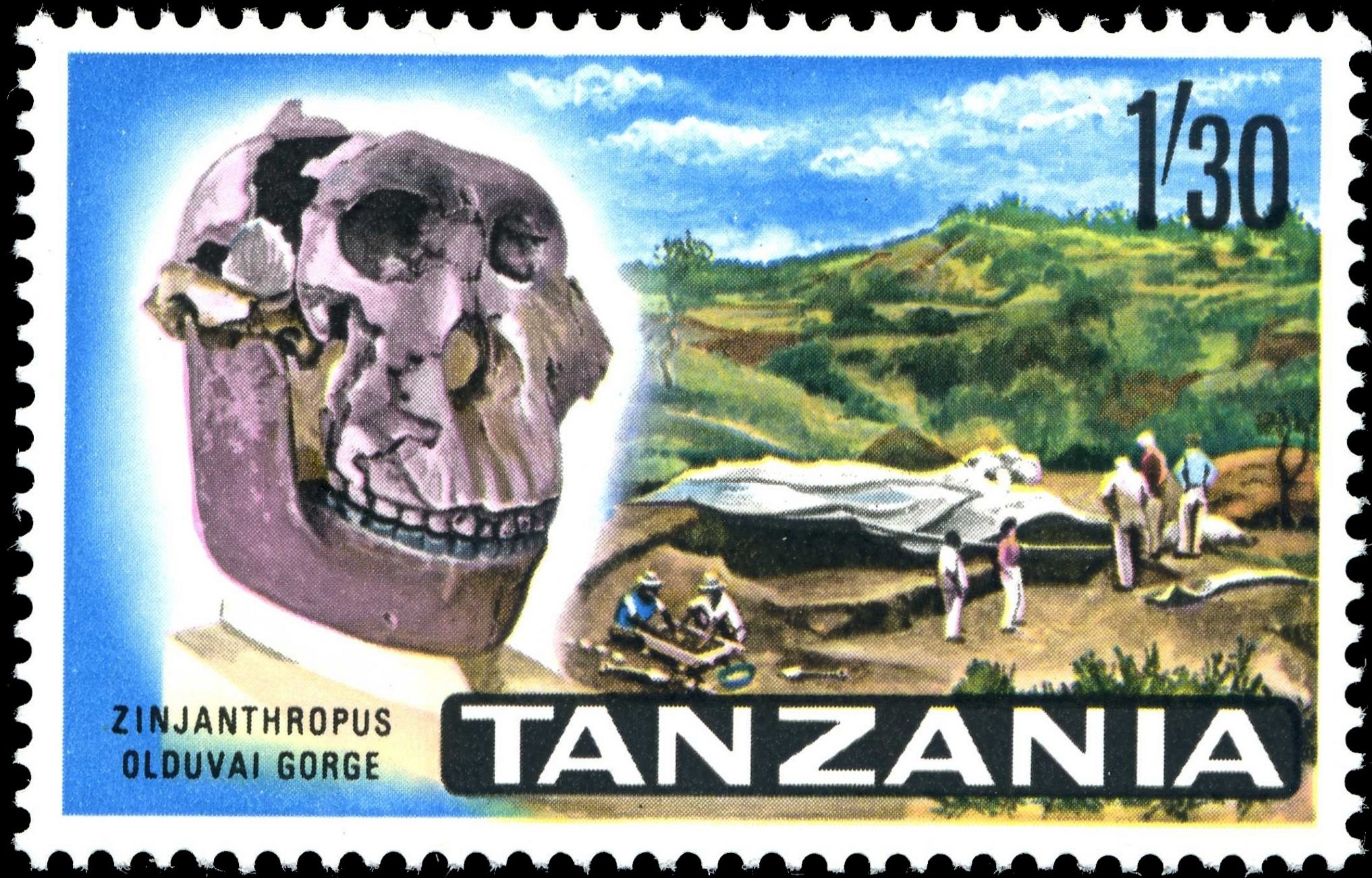 |
| A skull of Zinjanthropus and group of paleoanthropologists on stamp of Tanzania 1965 MiNr.: 14, Scott: 14. |
In his report, published in 1925, Dart concluded that the Taung child was a bipedal human ancestor, a transitional form between ape and human, who lived between 3.3 and 2.8 million years ago. However, Dart's conclusions were largely ignored for decades, as the prevailing view of the time was that a large brain evolved before bipedality.
In the 1930s, British- South African medical doctor and palaeontologist Robert Broom discovered and described a new species at Kromdraai, South Africa. Although similar in some ways to Dart's Australopithecus africanus (2.27-0.87 million-year-old), Broom's specimen had much larger cheek teeth. Because of this difference, Broom named his specimen Paranthropus robustus , using a new genus name.
Mary Leakey was a British paleoanthropologist and wife of Louis Leakey, a Kenyan-British Paleoanthropologist and archeologist. In 1959, Mary Leakey discovered fossils of a hominid at the Olduvai Gorge that she named Zinjanthropus boisei. Zinjanthropus boisei was later renamed Paranthropus boisei. This species of australopithecine lived during the Early Pleistocene between 2.5 and 1.15 million years ago. Louis Leakey described her fossils a month after their discovery. Both Leakeys were important proponents of the idea that humans evolved in Africa.
In the following year, the Leakeys discovered another unknown species of our ancestors, and assigned it to a new species, Homo habilis - an extinct species of archaic human from the Early Pleistocene of East and South Africa about 2.3 million years to 1.65 million years ago.
By the 1980s, Homo habilis was proposed to be an ancestor of humans, directly evolving into Homo erectus, which evolved into modern humans. This viewpoint is now debated.
In the late 1970s, Mary Leakey excavated the famous Laetoli footprints in Tanzania, which demonstrated the antiquity of bipedality in the human lineage.
Today, the Olduvai Gorge valley in Tanzania is counted as one of the most important paleoanthropological sites in the world; it has proven invaluable in furthering understanding of early human evolution. It is often called the "cradle of humankind".
This year is the 50th anniversary of the discovery of “Lucy”.
In 1974, fossils of the “Lucy” skeleton were excavated in Ethiopia. Lucy is a collection of several hundred pieces of fossilized bone comprising 40 percent of the skeleton of a female of the hominin species Australopithecus afarensis, dated to about 3.2 million years old.
 |
| Lucy skeleton on stamps of Ethiopia 1986 |
In Ethiopia, Lucy is known as Dinqnesh meaning “you are wonderful”.
Lucy became famous worldwide, and the story of her discovery and reconstruction was published in a book by Johanson and Edey. Beginning in 2007, the fossil reconstruction and associated artefacts were exhibited publicly in an extended six-year tour of the United States; the exhibition was called “Lucy's Legacy: The Hidden Treasures of Ethiopia”. There was discussion of the risks of damage to the unique fossils, and other museums preferred to display casts of the fossils. The original fossils were returned to Ethiopia in 2013, and subsequent exhibitions have used casts. The casts were purchased by many Natural History Museums around the world.
In the 21st century paleoanthropologists continue to make important discoveries, such as the discoveries of Homo naledi.
In 2015, a team led by Professor Lee Berger announced a new species, Homo naledi, based on fossils representing 15 individuals from the Rising Star Cave system in South Africa.
 |
 |
| Official and personalized FDCs FDC signed by Professor Lee Berger. Personalized FDC show reconstruction of Homo naledi on the cachet and Souvenir Sheet of South Africa 2017. |
Dr. Berger advertised on Facebook for very thin people who had to be scientifically sound and have caving experience. Six young women were selected out of almost sixty applicants from all over the world. They went underground, gathered the fossils whilst filming and relayed images to Berger and his team who were above ground. The bones were superbly preserved, and by March 2014, 1550 specimens in all, representing at least 15 individuals had been excavated; these included even the tiny bones of the ear canal.
Parts of the skeletons looked astonishingly modern though other parts were quite primitive. It was unclear how these fossils had made it into the cave. There was no sign that these hominids had fallen into the cave or had been dragged there by animals or even floods. There was also no evidence that they had lived in these caves. The fact that Homo naledi was not embedded in rock meant that dating the fossils became extremely difficult. Homo naledi was originally thought to be approximately 2 million years old, but research published in 2017 dates the oldest specimen of the species to be 335, 000 years old. The age of Homo naledi suggests that the species may have lived alongside Homo sapiens
Even though many mysteries in human evolution have been solved in the last 170 years, there are still many questions to be answered in the future.

|
Acknowledgements:
- Many thanks to fellow collector Mr. Peter Brandhuber from Germany for his support.
- Many thanks to Dr. Peter Voice from Department of Geological and Environmental Sciences, Western Michigan University, for reviewing the draft page .
References
- Paleoanthropology:
Wikipedia, Encyclopedia Britannica, New World Encyclopedia. - Neanderthal:
Wikipedia, Encyclopedia Britannica, Neanderthal Museum.- Gibraltar-1:
Wikipedia, Gibraltar National Musuem, Natural History Museum UK in London,
- Gibraltar-1:
- Piltdown Man:
Wikipedia, Encyclopedia Britannica, Natural History Museum UK in London, PBS, Science, Science History Institue. - Zhoukoudian Peking Man:
Wikipedia, Encyclopedia Britannica, UNESCO, Beijin Info. - Taung child (Australopithecus africanus):
Wikipedia, Encyclopedia Britannica, Live Science.- Professor Raymond Dart:
Wikipedia, Encyclopedia Britannica, The Leakey Foundation, Australian Dictionary of Biography, South African History Online,
- Professor Raymond Dart:
- Paranthropus robustus:
Wikipedia, Encyclopedia Britannica, Smithsonian National Museum of Natural History.- Robert Broom:
Wikipedia, Encyclopedia Britannica, South African History Online.
- Robert Broom:
- Zinjanthropus boisei / Paranthropus boisei:
Wikipedia, The Leakey Foundation, Smithsonian National Museum of Natural History.- Mary Leakey:
Wikipedia, Encyclopedia Britannica, The Leakey Foundation.
- Louis Leakey:
Wikipedia, Encyclopedia Britannica, The Leakey Foundation.
- Olduvai Gorge valley:
Wikipedia, Encyclopedia Britannica, Olduvai Gorge Project.
- Mary Leakey:
- Lucy (Australopithecus afarensis):
Wikipedia, Encyclopedia Britannica, Natural History Museum UK in London, Smithsonian National Museum of Natural History. - Homo naledi:
Wikipedia, Encyclopedia Britannica, Natural History Museum UK in London, Smithsonian National Museum of Natural History.- Professor Lee Berger:
Wikipedia, Encyclopedia Britannica, University of the Witwatersrand, Johannesburg.
- Professor Lee Berger: